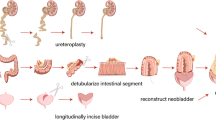Abstract
Purpose
To evaluate the urodynamic changes in patients who have undergone colocystoplasty (CCP), gastrocystoplasty (GCP) and ileocystoplasty (ICP) in a retrospective study. Changes in urinary continence, incidence of pathologic contractions before and after augmentation, alterations of urodynamic parameters were also examined.
Methods
Eighty-four patients were included in the study who underwent bladder augmentation between 1987 and 2017. Group I: 35 patients with CCP. Group II: 18 patients with GCP. Group III: 31 patients with ICP. Cystometry was performed at 3, 6, and every 12 months, then biannually after augmentation. Pre- and postoperative urodynamic changes were analysed statistically.
Results
In Group I, two patients and in Group III, one patient remained incontinent after CCP and ICP. Bladder capacity increased significantly, maximal intra-vesical pressure decreased and compliance improved in all groups (p < 0.001). Postoperative studies showed pathologic contractions in the augmented bladder in half of the patients with GCP, in 43% of patients after CCP and 26% of patients with ICP.
Conclusion
From the urodynamic point of view, ileum is the most adequate option in the long term. Contractions after augmentation might be caused by the remaining peristalsis of the detubularised segment. Further investigations are needed to evaluate pathologic contractions that remained after detubularisation.




Similar content being viewed by others

Data availability
No datasets were generated or analysed during the current study.
References
Mitchell ME (2003) Bladder augmentation in children: where have we been and where are we going? BJU Int 92:29–34
Rink RC (1999) Bladder augmentation. Options, outcomes, future. Urol Clin North Am 26:111–123
Juhasz Z, Jainsch M, Hock A, Farkas A, Pinter A (2000) The role and value of urodynamics in the follow-up of children with surgical bladder augmentation and substitution (article in Hungarian). Orv Hetil 141:1561–1565
Biers SM, Venn SN, Greenwell TJ (2012) The past, present and future of augmentation cystoplasty. BJU int 109:1280–1293
Scheepe JR, Blok BF, Hoen LA (2017) Applicability of botulinum toxin type A in paediatric neurogenic bladder management. Curr Opin Urol 27:14–19
Suskind AM, Dunn RL, Morgan DM, DeLancey JOL, McGuire EJ, Wei JT (2014) The michigan incontinence symptom index (M-ISI): A clinical measure for type, severity, and bother related to urinary incontinence. Neurourol Urodyn 33:1128–1134
Vajda P, Pinter AB, Harangi F, Farkas A, Vastyan AM, Oberritter Z (2003) Metabolic findings after colocystoplasty in children. Urology 62:542–546
Pinter AB, Vajda P, Juhasz Z (2008) Bladder augmentation in childhood: metabolic consequences and surgical complications – review and own investigations. J Pediatr Surg Spec 2:10–15
Kispal Z, Balogh D, Erdei O, Kehl D, Juhasz Z, Vastyan AM, Farkas A, Pinter AB, Vajda P (2011) Complications after bladder augmentation or substitution in children: a prospective study of 86 patients. BJU Int 108:282–289
Juhasz Z, Somogyi R, Vajda P, Oberritter Z, Fathi K, Pinter AB (2008) Does the type of bladder augmenation influence the resolution of pre-existing vesicoureteral reflux? Urodynamic studies. Neurourol Urodyn 27:412–416
Vajda P, Kaiser L, Magyarlaki T, Farkas A, Vastyan AM, Pinter AB (2002) Histological findings after colocystoplasty and gastrocystoplasty. J Urol 168:698–701
Kardos DJ, Kereskai L, Tornoczky T, Farkas K, Davidovics A, Farkas A, Vastyan AM, Pinter AB, Vajda P (2019) Re-evaluation of histological findings after colocystoplasty and gastrocystoplasty. J Pediatr Urol 15:651.e1-651.e8
DeFoor W, Minevich E, Reeves D, Tackett L, Wacksman J, Sheldon C (2003) Gastrocystoplasty: long-term followup. J Urol 17:1647–1650
Quek ML, Ginsberg DA (2003) Long-term urodynamics followup of bladder augmentation for neurogenic bladder. J Urol. 169:195–198
Obermayr F, Szavay P, Schaefer J, Fuchs J (2011) Outcome of augmentation cystoplasty and bladder substitution in a pediatric age group. Eur J Pediatr Surg 21:116–119
Radomski SB, Herschom S, Stone AR (1995) Urodynamic comparison of ileum vs. sigmoid augmentation cystoplasty for neurogenic bladder dysfunction. Neurourol Urodyn 14:231–237
Kilic N, Celayir S, Elicevik M, Sarimurat N, Söylet Y, Büyükünal C, Danişmend N (1999) Bladder augmentation: urodynamic findings and clinical outcome in different augmentation techniques. Eur J Pediatr Surg 9:29–32
Lopez Pereira P, Moreno Valle JA, Espinosa L, Alonso Dorrego JM, Martinez Urrutia MJ, Lobato Romera R, Jaureguizar Monereo E (2009) Are urodynamic studies really needed during bladder augmentation follow-up? J Pediatr Urol 5:30–33
Shekarriz B, Upadhyay J, Demirbilek S, Barthold JS, González R (2000) Surgical complications of bladder augmentation: comparison between various entercystoplasties in 133 patients. Urology 55:123–128
Acknowledgements
This research did not receive any specific grant from funding agencies in the public, commercial, or not-for-profit sectors.
Author information
Authors and Affiliations
Contributions
Data collection was done by ZSolt Juhász, Zoltán Kispál, Dániel Kardos and Péter Vajda. ZSolt Juhász and Zoltán Kispál and Dániel Kardos wrote the manuscript. Peter Vajda made the figures and tables to the manuscript. Review was done by ZSolt Juhász, Zoltán Kispál, Dániel Kardos and Péter Vajda.
Corresponding author
Ethics declarations
Conflict of interest
The authors declare no conflict of interests.
Additional information
Publisher's Note
Springer Nature remains neutral with regard to jurisdictional claims in published maps and institutional affiliations.
Rights and permissions
Springer Nature or its licensor (e.g. a society or other partner) holds exclusive rights to this article under a publishing agreement with the author(s) or other rightsholder(s); author self-archiving of the accepted manuscript version of this article is solely governed by the terms of such publishing agreement and applicable law.
About this article
Cite this article
Juhász, Z., Kispál, Z., Kardos, D. et al. Long-term urodynamic findings following colo-, gastro- and ileocystoplasty. Pediatr Surg Int 40, 131 (2024). https://doi.org/10.1007/s00383-024-05714-z
Accepted:
Published:
DOI: https://doi.org/10.1007/s00383-024-05714-z



